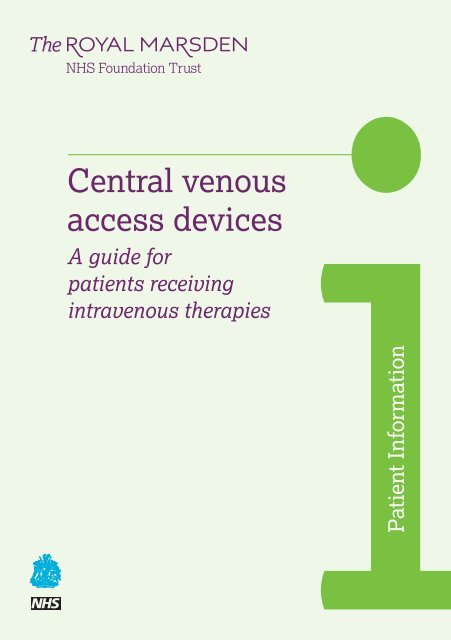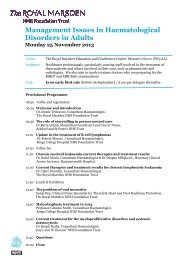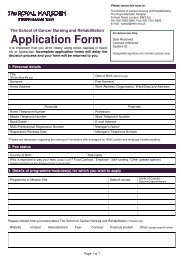Central Venous Access Devices - The Royal Marsden
Central Venous Access Devices - The Royal Marsden
Central Venous Access Devices - The Royal Marsden
Create successful ePaper yourself
Turn your PDF publications into a flip-book with our unique Google optimized e-Paper software.
<strong>Central</strong> venousaccess devicesA guide forpatients receivingintravenous therapiesi
ForewordThis is one of a series of booklets written to provide information forpatients and their relatives. It is impossible to include everything youmay need to know. Your doctor or nurse will be able to answer specificquestions.This booklet has been prepared by <strong>Royal</strong> <strong>Marsden</strong> specialist nurses,with input from doctors and patients.We hope you find it helpful and would welcome your comments so thatthe next edition can be improved further.
<strong>Central</strong> venous access devicesContentsIntroduction 1What is a central venous access device (CVAD)? 1What are the advantages of having a central venousaccess device? 1What are the disadvantages of having a central venousaccess device? 2What types of CVADs are available? 2How will I know what device to choose? 2Peripherally inserted central catheters (PICCs) 4What is a PICC? 4What are the advantages of a PICC? 4What are the disadvantages of a PICC? 5How is the catheter inserted? 5How do I care for the PICC? 6How does the PICC dressing get changed? 6How do I flush the catheter? 8What equipment will I be given? 9How is the catheter removed? 9Skin-tunnelled catheters 10What is a skin tunnelled catheter? 10What are the advantages of a skin-tunnelled catheter? 10What are the disadvantages of a skin-tunnelled catheter? 11How is the catheter inserted? 11How do I care for the skin-tunnelled catheter exit site? 12How do I flush the catheter? 12What equipment will I be given? 13How is the catheter removed? 13
Implanted ports 15What is an implanted port? 15What are the advantages of an implanted port? 15What are the disadvantages of an implanted port? 15How is the port inserted? 16How do I care for the port? 17How is the port removed? 17Are there any risks involved in the insertion of a CVAD? 17In what circumstances should I contact the hospital? 18Insertion details 19Record of port access 20Notes/Questions 21Sources of information and support 22Where can I get help? 23
<strong>Central</strong> venous access devicesIntroductionSome of the treatment you require will need to be given directly intoyour bloodstream. In order to do this, we will place a device intoyour vein, called a venous access device. This enables us to haveaccess to your venous system to give your therapy.<strong>The</strong>re are several different types of devices available. One type iscalled a peripheral cannula. It is a small plastic tube that is insertedinto a vein in your lower arm or hand, through a needle. This needleis then removed, leaving the cannula in place for a few hours or upto three days while you have treatment. We will remove the cannulawhen you finish treatment. You will be given a new cannula everytime you need treatment.Sometimes, this can affect the veins and make it harder to insert thecannula into a vein. If this happens it may be suggested that youhave a central venous access device put in instead. Some treatmentdrugs cannot be given into the veins of the hand or the arm and canonly be given, through a central venous access device, into a largervein leading to your heart.What is a central venous access device (CVAD)?A central venous access device (CVAD) is made of a non-irritantmaterial, for example, silicone, which means it can be left in placefor several weeks or months. <strong>The</strong> CVAD may contain one or twotubes. When a CVAD contains two tubes, it is called a double ordual lumen catheter.What are the advantages of having a central venousaccess device?Whatever the type of CVAD, it can be used to give you fluids anddrugs. It may also be used to take blood samples. <strong>The</strong> CVAD willsave you or your child from having repeated needle pricks fromblood taking or insertion of cannulas during treatment.1
What are the disadvantages of having a central venousaccess device?With any CVAD, there is a risk of infection and a clot formingaround the catheter (thrombosis). If you are at risk of developinga thrombosis you may be given a drug called warfarin (a bloodthinning agent) to reduce the risk of this occurring. <strong>The</strong>re may alsobe times when it is not possible to take blood samples from any ofthe CVADs.What types of CVADs are available?<strong>The</strong>re are three main types of CVADs:• A peripherally inserted central catheter (PICC) (see page 4)• A skin-tunnelled catheter (see page 10)• An implanted port (see page 15).Each of these devices is described in more detail in this booklet.How will I know which device to choose?You may be able to choose from any of the three main types ofCVADs. However, your choice will depend on the type of therapyyou are going to have and your physical condition. Your choice maybe limited, for example, if you have no suitable veins in your arms oryou cannot have a general anaesthetic or you have had lymph nodesremoved during breast surgery. Even if you have no choice aboutthe type of device, you may be able to discuss how and where thedevice will be placed.<strong>The</strong> table below shows at a glance, the main features of the threedifferent types. More detailed information about each individual typefollows afterwards. However, talk through your choice of device withyour nurse, as there may be variations between different hospitals.2
<strong>Central</strong> venous access devicesPeripherallyinserted centralcatheter (PICC)Skin-tunnelledcatheterImplanted portDo I have togo to theatreand have ananaesthetic?Will it leaveany scars whenremoved?Can I bath andshower with itin?Will I still haveto have needlesinserted for mytreatment?Can I swimwith it in?NoYesBut only a localanaesthetic andsedationYesYou will needa generalanaestheticNo Yes YesYesBut you can’tsoak your armin the bathYesBut you can’tsubmerge yourchest in the bathYesNo No YesNo No YesDo I need to havethe dressingchanged?YesOnce a weekYesbut only for thefirst three weeksNoDoes it need tobe flushed?YesOnce a weekYesOnce a weekYesOnce a month3
Peripherally inserted central catheters (PICCs)What is a PICC?A peripherally inserted central catheter (PICC) is a tube, which isinserted into a vein in the top of your arm, above the bend of theelbow. It is moved up into the large vein leading to your heart. APICC can be placed in either arm.What are the advantages of a PICC?• You do not have to go to theatre to have it inserted• You do not need a surgical procedure to insert or remove it• It does not leave any scars• <strong>The</strong>re is less risk of complication during insertion4
<strong>Central</strong> venous access devicesWhat are the disadvantages of a PICC?• <strong>The</strong> dressing needs to be changed once a week by a carer/relative or nurse• You can’t go swimming with a PICC and it may restrict youcontinuing with other vigorous sporting activities.• It cannot be used for any nuclear medicine test injections andmay only be used for CT or MRI scan injections in certaincircumstances.How is the catheter inserted?VeinCatheterClampInjectioncapHeartDiagram of a PICCA nurse or doctor will locate your vein using an ultrasound machineand then inject a local anaesthetic to remove the sensation from theskin over the vein. A small cannula is inserted into the vein and thenan introducer is inserted through which the catheter is threadeduntil the tip is in the correct position. <strong>The</strong> introducer is thenremoved and only the catheter is left. A special device is clipped tothe PICC to secure it in place on the skin.5
A dressing and some extra padding are placed over the catheter.This is to reduce any bleeding which may occur in the first 24 hours.A chest x-ray will be taken to check that the PICC is in the rightplace.How do I care for the PICC?Initially, the dressing must be changed within the first 24 hoursfollowing insertion of the PICC and the extra padding removed.This is because there can be leakage of blood which may cause thedressing to lift or become unstuck. <strong>The</strong> dressing will usually bechanged before you leave hospital. If you are not staying in hospital,you’ll be asked to come back to the hospital the following day tohave your dressing changed. If this is difficult for you, then we cantry and arrange for your district nurse to change your dressing. Afterthis first time, the dressing will only need to be changed once aweek. This can be done by a district nurse or we can teach a relativeor friend to do this for you when you are at home.You should have a shower, bath or all over wash every day to keepyour skin generally clean.<strong>The</strong> transparent dressing over the exit site is waterproof. However,take care not to get the catheter or extension set wet. <strong>The</strong> dressingmust remain clean, dry and stuck firmly to your skin. You will begiven a waterproof sleeve to wear in the shower to protect the PICC.<strong>The</strong> Statlock securing device keeps the PICC securely in place andwill be changed when loose or dirty.During the first week after your catheter has been inserted, thecatheter site may be red and inflamed. Warmth, like a covered hotwater bottle and resting the arm on a pillow, may relieve this. Youcan use warmth for the first 48 hours to reduce the likelihood of thishappening. If it doesn’t help, contact the hospital.How does the PICC dressing get changed?This procedure describes changing the initial dressing with theextra padding. After this first dressing change, the transparentdressing will then need to be changed once a week following thesame steps (excluding step 6).6
<strong>Central</strong> venous access devices1. Gather all the items you need on a clean surface.2. Wash your hands and open the dressing pack.3. Remove the bandage and gauze.4. Place the dressing towel under the arm and open the ChloraPrepsponge onto the pack.5. Carefully peel off the old transparent dressing and throw it away.6. <strong>The</strong>n carefully remove the steristrips and the gauze dressingover the insertion site and throw them away (this gauze dressingdoes not need to be replaced unless instructed).7. Wash your hands, dry well and put on gloves.8. Clean around the catheter with the sponge, using backward andforward movements. Allow the area to dry.Cleaning around the catheter7
9. If necessary, remove the Statlock securing device, taking carenot to pull the catheter. Attach the PICC to the new Statlockbefore applying it to the skin.10. Open the transparent dressing and remove sheet 1.11. Place the dressing on the arm so that it covers the catheterinsertion site and the Statlock.Opsite IV3000StatlockInsertionsite12. Press the dressing into place as you remove sheets 2 and 3.13. Wrap the lumen/s in gauze to prevent pressing into the skin.14. Finally, place a bandage or tubigrip over the gauze, but not overthe transparent dressing, as it allows any moisture to escapefrom the site and helps to prevent infection.How do I flush the catheter?<strong>The</strong> catheter must be kept clear by injecting it (flushing) withheparinised saline. You will use 5ml (50iu) of heparinised salineonce a week, after your dressing has been changed. If you havea dual lumen catheter you must inject both tubes in the waydescribed. <strong>The</strong> injection caps will need to be changed once a weekat the time of flushing.8
<strong>Central</strong> venous access devices1. Wash your hands well, and dry them.2. Fit a blue needle on the end of the syringe.3. Break the heparinised saline ampoule as instructed.4. Draw up the heparinised saline and remove any air.5. Remove the needle from the syringe.6. Clean the connection between the cap and the catheter with analcohol swab, let it dry and then remove the old injection cap.7. Open the new injection cap and remove the plastic cover.8. Attach to the end of the catheter.9. Attach the syringe onto the cap.10. Slowly inject the contents of the syringe 1ml at a time.11. Remove the syringe, keeping the pressure on the plunger of thesyringe.12. Dispose of your used equipment as you have been told, into thespecial sharps container.What equipment will I be given?• A PICC pack containing ChloraPrep swabs to use when cleaningaround the catheter, Opsite IV3000 dressings, a Statlock, gauzeswabs, bandages and dressing packs.• A flushing kit containing needleless injection caps to seal endof the catheter, alcohol swabs, a supply of heparinised salineampoules as well as some needles and syringes.Further equipment will be supplied as necessary.How is the catheter removed?Taking out a PICC is not a special procedure. It will be similar tohaving a cannula removed. <strong>The</strong> nurse will place your arm on apillow and then remove the dressing. <strong>The</strong>n s/he will gently pullthe catheter out of the vein and apply a dressing to the site. Thisdressing can be removed after 24 hours.9
Skin-tunnelled cathetersWhat is a skin-tunnelled catheter?A skin-tunnelled catheter is a tube (sometimes called a ‘Hickman’line) which is inserted through your chest into a large vein leadingto your heart. Along the catheter, there is a small cuff which youmay be able to feel through your skin. This cuff prevents the catheterfrom moving or falling out. <strong>The</strong> catheter can be inserted on eitherside of your chest.What are the advantages of a skin-tunnelled catheter?• It does not need any dressings once the stitches are removed.10
<strong>Central</strong> venous access devicesWhat are the disadvantages of a skin-tunnelled catheter?• You will need to go to theatre to have the catheter inserted. Thisis carried out under sedation using local anaesthetic.• It does require a surgical procedure to remove it (but not intheatre).• You will be left with three small scars.• You cannot go swimming while you have a skin-tunnelledcatheter but your other activities should not be restricted.• It cannot be used for any nuclear medicine test injections andmay only be used for CT or MRI scan injections in certaincircumstances.How is the catheter inserted?VeinCatheterCuffClampHeartInjection capDiagram of a skin-tunnelled catheterYou will be admitted to hospital for the day. A doctor will insert thecatheter, usually using a local anaesthetic, which numbs an area onyour chest. You will also be given a sedative to relax you and makeyou sleepy. Occasionally a general anaesthetic may be used.11
Only two small cuts will be made on your chest, one to tunnel thecatheter and the other, near to your collar bone, to insert it into yourvein. You will have two stitches, one where each cut has been made.You will be told when and by whom these should be removed.After the catheter has been inserted, your shoulder may feel stiff andpainful for a couple of days. You may find painkillers help relieve thediscomfort. A chest x-ray will be taken to check that the catheter isin the right place.How do I care for the skin-tunnelled catheter exit site?<strong>The</strong> dressings are changed after the first 24 hours and then oncea week until the stitches are removed at three weeks. You will notneed to have a dressing once the stitches have been removed.However, some people prefer to tape a small piece of gauze over theexit site. This should be changed every day.You should have a shower, bath or all over wash every day to keepyour skin generally clean. If you do not shower, then you shouldclean around the exit site with cooled boiled water and cotton woolwhen you wash or when you change the gauze dressing.How do I flush the catheter?<strong>The</strong> catheter must be kept clear by injecting it (flushing) withheparinised saline. You will use 5ml (50iu) of heparinised salineonce a week. If you have a dual lumen catheter you must injectboth tubes in the way described. <strong>The</strong> injection caps will need to bechanged once a week at the time of flushing.1. Wash your hands well and dry them.2. Fit a blue needle on the end of the syringe.3. Break the heparinised saline ampoule as instructed.4. Draw up the heparinised saline and remove any air.5. Remove the needle from the syringe.6. Clean the connection between the cap and the catheter with analcohol swab, let it dry and then remove the old injection cap.7. Open the new injection cap and remove the plastic cover.12
<strong>Central</strong> venous access devices8. Attach to the end of the catheter.9. Attach the syringe onto the cap and open the clamp.10. Slowly inject the contents of the syringe 1ml at a time.11. Remove the syringe, keeping the pressure on the plunger of thesyringe. Only close the clamp after the syringe has been removed.12. Dispose of your used equipment as you have been told, into thespecial sharps containerWhat equipment will I be given?• A pack with gauze, tape and a pouch for supporting the skintunnelledcatheter• A flushing kit containing needleless injection caps to seal theend of the catheter, alcohol swabs, a supply of heparinisedsaline ampoules as well as some needles and syringes.Further equipment will be supplied as necessary.How is the catheter removed?If you are taking Warfarin 1mg you will need to stop four daysbefore the catheter is removed. If you are taking Warfarin for athrombosis or any other reason (and carry a yellow Warfarin book)tell the nursing staff or doctors as you may need a different type ofanticoagulant.Usually, you will be admitted as a day case and be in hospitalfor three to four hours. You may eat and drink on the day of theprocedure as it is carried out under local anaesthetic on the ward.When you arrive at the hospital, a blood sample will be taken tocheck platelets, haemoglobin, and clotting rate. <strong>The</strong>se are done tomake sure that there is no risk of bleeding during the procedure.You will then be free to relax until the results of the tests areavailable. This usually takes about two hours. If these results are notsatisfactory it will not be safe to remove the catheter and you may beasked to return in a few days. You will also be asked if you have hadany oozing, redness, swelling or pain at the exit site of the catheter.13
<strong>The</strong> procedure is carried out by a specially trained nurse or doctorand usually takes about 30 minutes. You will be asked to lie flat onthe bed with one pillow. If you have difficulty lying flat then pleaselet the nursing staff know.You may have felt a small lump under the skin where the catheter is– this is the cuff (see diagram page 11). If the lump is not visible, thenurse or doctor will check its location using a tape measure. A localanaesthetic is then injected under the skin around the cuff. Thiswill sting for a minute or two. When the area is numb, a small cut ismade in the skin and the catheter is removed. You may feel a pullingand pushing sensation but you are unlikely to feel pain. However, ifyou do feel pain let the nurse or doctor know and they can give youmore anaesthetic.Once the catheter is out, the cut is stitched with two or threestitches. A dressing will be applied to the wound. You will beasked to continue lying flat for 30 minutes and if there is no furtherbleeding, you will be able to leave the hospital. You will be able todrive after the procedure.You will need to dress the area each day until the stitches areremoved. So if you have any dressing, gauze, or tape at home, thenkeep them to use for the dressings. If you need more dressings,these will be supplied before you are sent home.If the wound bleeds within the first 24 hours you will need to applya further dressing over the original one. If the bleeding continuesor you are concerned then please telephone the ward. This furtherbleeding may result in a bruise, but this is normal.If you have any pain following the removal of the catheter you maytake painkillers that you would normally take for a headache.Following removal you should:• Avoid heavy lifting for the first 24 hours• Avoid getting the stitches wet• Contact your district nurse or GP practice nurse to organise forthe stitches to be removed after seven days.14
<strong>Central</strong> venous access devicesImplanted portsWhat is an implanted port?A portA port with special needleAn implanted port (sometimes called a ‘Portacath’) is a device,which is inserted under the skin into your body. <strong>The</strong> usual positionis on the chest. It can be placed on either side of your chest. <strong>The</strong>port is made up of a portal body and this is connected via a thintube (catheter) inserted into one of the body’s veins – see diagrambelow. <strong>The</strong> port can be felt through the skin. Entry to the port isgained by puncturing the silicone membrane with a special typeof needle, which is attached to a length of tubing (an extensionset). This will allow you to receive fluids and drugs or have bloodsamples taken from it. Puncturing the port is similar to prickingthe skin with a pin. Naturally it takes some getting used to. If it ispainful, we can apply local anaesthetic gel to the area 30 minutesbefore we insert the needle to numb the skin.What are the advantages of an implanted port?• It only needs to have the needle put in when we need to use it.• <strong>The</strong> needle is removed in between treatments and you will nothave to worry about any dressings or flushing the catheter.• It doesn’t restrict your normal activities including swimming.What are the disadvantages of an implanted port?• You still need to have a needle inserted each time the port isused. <strong>The</strong> port can sometimes be difficult to access.15
• You will need to go to theatre or other specific department forthe insertion and removal, which is carried out under general (orsometimes local) anaesthetic.• Most ports only provide a single lumen for access so if youneed more complex therapies, then you may also need to haveperipheral cannulas inserted.• It will leave some scars and if you are worried about scars thendiscuss this with the surgeon. However in order for the surgeonto position the port to reduce scars, the nurses may find it moredifficult to gain access to it. As a result, you may find the needleaccess procedure more uncomfortable.• If you need to have blood tests, for example, at your GP surgery,or local hospital you may find that the surgery staff are nottrained to take blood from a port.• It cannot be used for any nuclear medicine test injections andmay only be used for CT and MRI scan injection in certaincircumstances.How is the port inserted?Extension setNeedleSilicone membraneSkinPortal bodyMuscleStitchCatheterVeinDiagram of an implanted portYou will usually be admitted to hospital for the day, unless you arecoming in overnight for your treatment. It is advisable not to drive ifyou are in for the day and you should arrange for someone to collectyou after the procedure.16
<strong>Central</strong> venous access devices<strong>The</strong> port is inserted by a surgeon and usually takes place under ageneral anaesthetic. Two small cuts will be made. One to form apocket for the port to sit in and the other, an entry site used by thesurgeons to put the catheter through. <strong>The</strong> stitches over the pocketare usually dissolvable. <strong>The</strong> stitches at the entry site may need tobe removed after seven to ten days or may be dissolvable. A chestx-ray will be taken to check that the port and catheter are in the rightplace.How do I care for the port?<strong>The</strong>re is no special care needed for a port. <strong>The</strong> needle is removedin between treatments and you will not have to worry about anydressings or flushing the port.How is the port removed?<strong>The</strong> port is removed under general anaesthetic, usually as a daycase.Are there any risks involved in the insertionof a CVAD?Occasionally there can be complications when inserting a catheter.For example, with a port or skin-tunnelled catheter, the needle orguide wire can scratch the top of your lung causing a pneumothorax(an air pocket). You would probably be unaware of this but youmay become slightly breathless. A pneumothorax would show upon x-ray and would be treated straight away. This wouldn’t causeany long term problems. <strong>The</strong> catheter may also not thread into thecorrect position; this is more likely with a PICC. A chest x-ray istaken after the catheter has been inserted to check that it is correctlypositioned also to check there is no pneumothorax. Sometimes theremay be bruising at the site where the needle went into your vein.17
In what circumstances should I contact the hospital?Contact the hospital immediately if you notice any of the following:• You develop a high temperature, fever, chills or flu likesymptoms (this could be an infection) – refer to your alert card.• Your arm, neck or shoulder is swollen and painful (this could bea sign of a blood clot).• You have pain or burning when flushing the catheter.• You can’t flush your catheter easily without resistance – thiscould indicate that the catheter has become blocked (never useforce when flushing the catheter).• Your catheter is cracked or broken (fold/clamp the tubing andtape it securely).• Your catheter is pulled out – which may mean the tip of thecatheter is not in the correct position.• You think your catheter site looks red and inflamed, there is anydischarge or the redness is tracking up your arm from your PICC(after the first week) – could be early signs of infection.• Your PICC is leaking under the dressing.• Your PICC is partially pulled out (that is the amount of exposedcatheter is more than ______cm). Do not attempt to push it backin.18
<strong>Central</strong> venous access devicesInsertion detailsAll devices:Type of device:PICC Skin-tunnelled catheter Implanted portInsertion dateInsertion byBrand of CVADLumens — single dual tripleSize of catheter (French) — 4 / 5 / otherTip location —Additional information on PICC:Arm used — left / rightVein usedLength of catheter insertedExternal markings on catheter showingcmAny other comments:19
Record of port accessDateofaccessNumberofattemptsGauge size/length ofneedleTimeneedlein situAny problems20
<strong>Central</strong> venous access devicesNotes/QuestionsYou may like to use this space to make notes or write questions asthey occur to you, to discuss with your specialist nurse or doctor.21
Sources of information and supportMacmillan Cancer Support89 Albert EmbankmentLondon SE1 7UQMacmillan freephone helpline: 0808 808 0000Website: www.macmillan.org.ukProvides free information and emotional support for people livingwith cancer and information about UK cancer support groups andorganisations. Offers free confidential information about cancertypes, treatments and what to expect.WebsiteNational Institute for Health and Clinical Excellence (NICE)MidCity Place71 High HolbornLondon WC1V 6NAWebsite: www.nice.org.ukNICE provides guidance for healthcare professionals, and patientsand their carers that will help to inform their decisions abouttreatment and healthcare.Department of Health guidanceClean, safe care: reducing infections and saving lives(January 2008)This document draws together initiatives to tackle healthcareassociated infections and improve cleanliness to ensure thatpatients receive clean and safe treatment whenever and whereverthey are treated by the NHS.22
<strong>Central</strong> venous access devicesWhere can I get help?If anything unusual occurs, if you have any problems or are worriedabout any aspects of your CVAD, please contact:Ward/departmentTelephone numberYour nurse specialistTelephone numberatHospitalTelephone number23
Copyright © August 2004 <strong>The</strong> <strong>Royal</strong> <strong>Marsden</strong> NHS Foundation TrustAll rights reservedRevised August 2012Planned review August 2014This booklet is evidence based wherever the appropriate evidence is available, andrepresents an accumulation of expert opinion and professional interpretation.Details of the references used in writing this booklet are available on requestfrom: <strong>The</strong> <strong>Royal</strong> <strong>Marsden</strong> Help CentreFreephone: 0800 783 7176Email: patientcentre@rmh.nhs.uk<strong>The</strong> <strong>Royal</strong> <strong>Marsden</strong> NHS Foundation TrustFulham RoadLondon SW3 6JJwww.royalmarsden.nhs.ukNo part of this booklet may be reproduced in any way whatsoever withoutwritten permission except in the case of brief quotations embodied in criticalarticles and reviews.No conflicts of interest were declared in the production of this booklet.<strong>The</strong> information in this booklet is correct at the time of going to print.Printed byLundie Brothers Ltd.Croydon, SurreyPI-0084-05
<strong>The</strong> <strong>Royal</strong> <strong>Marsden</strong> publishes a number of bookletsand leaflets about cancer care. Here is a list ofinformation available to you.iDiagnosis• A beginner’s guideto the BRCA1 andBRCA2 genes• CT scan• MRI scan• Ultrasound scanPatient InformationTreatment• <strong>Central</strong> venous accessdevices• Chemotherapy• Clinical trials• Radiotherapy• Radionuclide therapy• Your operation andanaestheticiPatient InformationiSupportive Care• After treatment• Coping with nausea andvomiting• Eating well when you havecancer• Lymphoedema• Reducing the risk ofhealthcare associated infection• Support at home• Your guide to support,practical help andcomplimentary therapiesPatient InformationiYour hospitalexperience• Help Centre for PALSand patient information• How to raise a concernor make a complaint• Your comments please• Your healthinformation, yourconfidentialityPatient Information
















